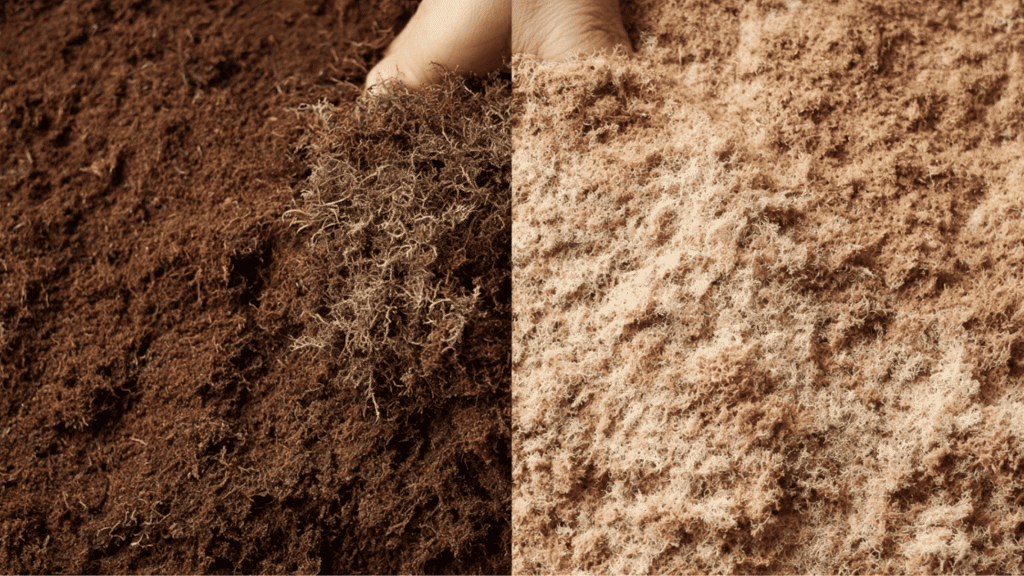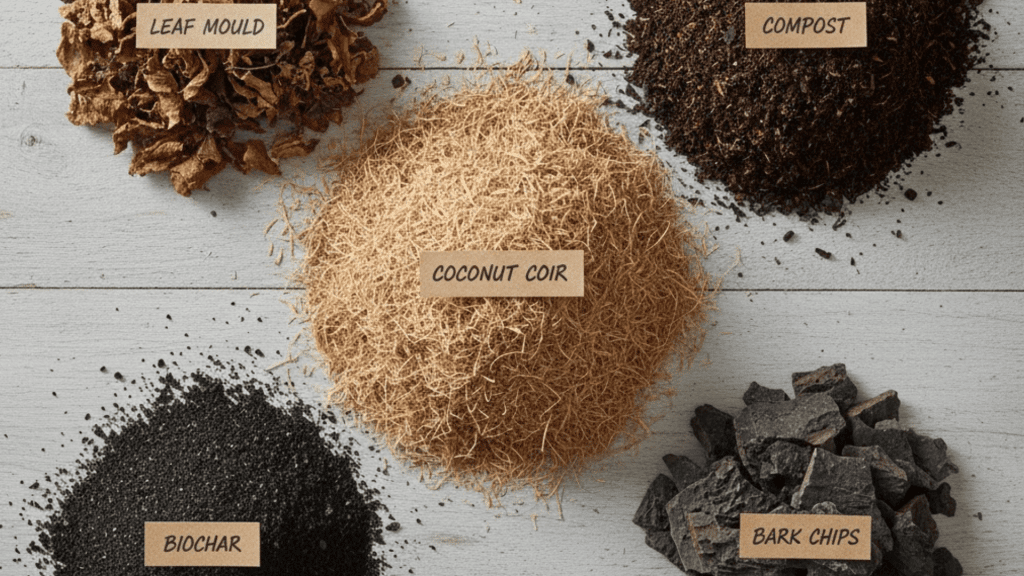Peat moss is a familiar name to many gardeners, often found on bags of potting mix and soil improvers. But what exactly is it, and why is it so widely used?
This soft, fibrous material is valued for improving soil texture and helping plants retain moisture. Yet, while it offers clear benefits for gardening, its use also raises important environmental concerns.
Understanding how peat moss forms, what it does for soil, and the impact of its harvesting helps gardeners make choices that are better for both plants and nature.
There are also sustainable alternatives that offer similar results without harming delicate ecosystems.
What Is Peat Moss?
Peat moss is a soft, brown material made from layers of partially decomposed plants, mostly sphagnum moss, that build up in cold, waterlogged bogs over thousands of years.
It forms in oxygen-poor and acidic conditions, which slow decay and preserve the fibrous texture that gardeners value.
Much of the peat moss sold in North America comes from Canada’s vast peatlands.
It’s lightweight, spongy, and can hold several times its weight in water, making it ideal for keeping soil moist.
Naturally acidic, with a pH between 3.5 and 4.5, peat moss has little nutrient content but improves soil structure.
These qualities have made it a common ingredient in potting mixes and soil conditioners.
What Does Peat Moss Do for Soil?

Peat moss improves soil structure, moisture balance, and plant growth by changing texture, water retention, and pH levels.
1. Improves Soil Structure & Texture
In clay soils, peat moss loosens compact layers, improving air circulation and drainage. In sandy soils, it adds structure, helping the ground retain moisture.
This balance creates a softer, more crumbly soil that supports strong root development and reduces surface crusting, making it easier for plants to grow.
2. Increases Water Retention & Moisture Regulation
Peat moss acts like a sponge, holding several times its weight in water. It keeps soil evenly moist, reducing the need for frequent watering.
This makes it especially useful in dry climates or for container gardens where consistent moisture is essential for plant health.
3. Adjusts pH & Suits Acid-Loving Plants
Its natural acidity helps lower soil pH, creating an ideal environment for plants that thrive in acidic conditions, such as blueberries, azaleas, and rhododendrons.
However, gardeners should use it carefully in neutral or alkaline soils to prevent making the soil too acidic for certain crops.
4. Sterility & Use in Potting Mixes/Seed Starts
Commercial peat moss is typically clean and free from weed seeds or pathogens.
It’s often mixed with perlite or vermiculite to create soilless blends that support healthy seed germination and root growth without introducing harmful organisms or unwanted plants.
5. Important Considerations
Peat moss contains almost no nutrients, so fertilizers or compost are still necessary. When it dries completely, it becomes water-repellent and hard to moisten again.
Because it changes soil moisture and pH, gardeners should use it in moderation and tailor its use to specific plant needs.
Environmental Impact of Harvesting and Using
Peat moss offers gardening benefits but comes with serious environmental costs affecting ecosystems, carbon balance, and long-term sustainability.
- Peatlands as Ecosystems: Peatlands are vital wetlands that store carbon, support biodiversity, and regulate water flow across landscapes.
- Carbon and Climate Impact: Harvesting peat releases trapped carbon dioxide into the atmosphere, worsening global warming and reducing natural carbon sinks.
- Non-Renewable Resource: Peat takes thousands of years to form, making its extraction unsustainable and impossible to replace within human timescales.
- Habitat Destruction: Removing peat disrupts water systems, destroys wildlife habitats, and alters soil and vegetation in sensitive wetland regions.
- Regulatory Concerns: Many countries are imposing stricter rules and ethical standards to limit peat use and protect natural peatland reserves.
Peat moss improves soil, but its extraction damages ecosystems, urging gardeners to adopt responsible, sustainable alternatives for long-term environmental health.
Pros and Cons of Peat Moss
Peat moss offers helpful gardening qualities but also carries limitations that make it less suitable for long-term, sustainable soil care.
| Pros | Cons |
|---|---|
| This process improves aeration and prevents soil compaction, helping roots grow more freely. | Becomes difficult to rewet once completely dry, reducing effectiveness. |
| This product acts as a clean, sterile base for seed starting and indoor plants. | This soil offers no significant nutrients to plants and requires additional fertilization. |
| This product is lightweight and easy to mix into garden soil or potting blends. | Extraction and transport increase carbon emissions and ecological footprint. |
| Extends soil moisture retention during short droughts or hot weather. | Overuse can make soil overly acidic, harming neutral or alkaline-loving plants. |
| Helps reduce soil crusting, keeping the top layers breathable for seedlings. | Peat supply depends on limited natural reserves, making it less sustainable. |
Peat moss works well for gardening needs, but using it mindfully and opting for limited or sustainable alternatives is better for long-term environmental balance.
Alternatives to Peat Moss

Peat moss can be replaced with several eco-friendly materials that improve soil health while protecting the environment.
- Coconut Coir (Coco Coir): Made from coconut husks, it retains moisture well, improves aeration, and is fully renewable.
- Compost: Decomposed organic matter adds nutrients, improves structure, and promotes healthy soil microbes naturally.
- Leaf Mould: Made from decomposed leaves, it boosts soil structure, increases moisture retention, and supports beneficial organisms.
- Wood Fibre or Bark Fines: By-products of forestry that enhance drainage, aeration, and provide texture to potting mixes.
- Biochar: A carbon-rich material that improves water retention, supports soil microbes, and helps store carbon long-term
These materials offer sustainable, locally available, and effective options for gardeners aiming to reduce peat moss use.
Other Uses of Peat Moss
Peat moss serves more than one role in gardening and landscaping.
It’s commonly used for starting seeds since it provides a clean, moisture-retaining base that encourages germination.
Many gardeners mix it into potting soil to improve drainage and consistency for container plants. It also works as a topdressing on lawns to aid new grass growth and maintain moisture.
In landscaping, peat moss helps improve poor soils and supports acid-loving plants such as azaleas and blueberries.
Despite its benefits, using it sparingly helps reduce environmental impact.
Final Thoughts
Choosing the right soil materials means thinking about both plant health and environmental responsibility.
Peat moss has its place, but using it wisely or switching to renewable alternatives supports a healthier planet.
Small gardening choices, like using compost, coir, or leaf mould, can make a big difference over time.
Every gardener can help protect peatlands and reduce carbon release by opting for sustainable options.
Start by testing your soil, learning its needs, and choosing eco-friendly amendments that improve growth without harming nature.
Make your garden thrive while preserving the environment, because healthy soil builds a better future for everyone.
Frequently Asked Questions
Can Peat Moss Be Reused After A Growing Season?
Yes, it can be reused by mixing with compost or soil to restore texture and moisture-retaining ability for garden beds.
Does Peat Moss Attract Pests Or Mold?
Peat moss is sterile and pest-free, but excessive moisture may cause mold growth. Keep it dry and well-aerated.
Is Peat Moss Safe For Indoor Plants?
Yes, it’s ideal for indoor plants, maintaining moisture and improving aeration in pots while supporting healthy root development.
How Should Peat Moss Be Stored For Future Use>
Store in a cool, dry, sealed container away from sunlight and moisture to maintain texture and prevent mold.

